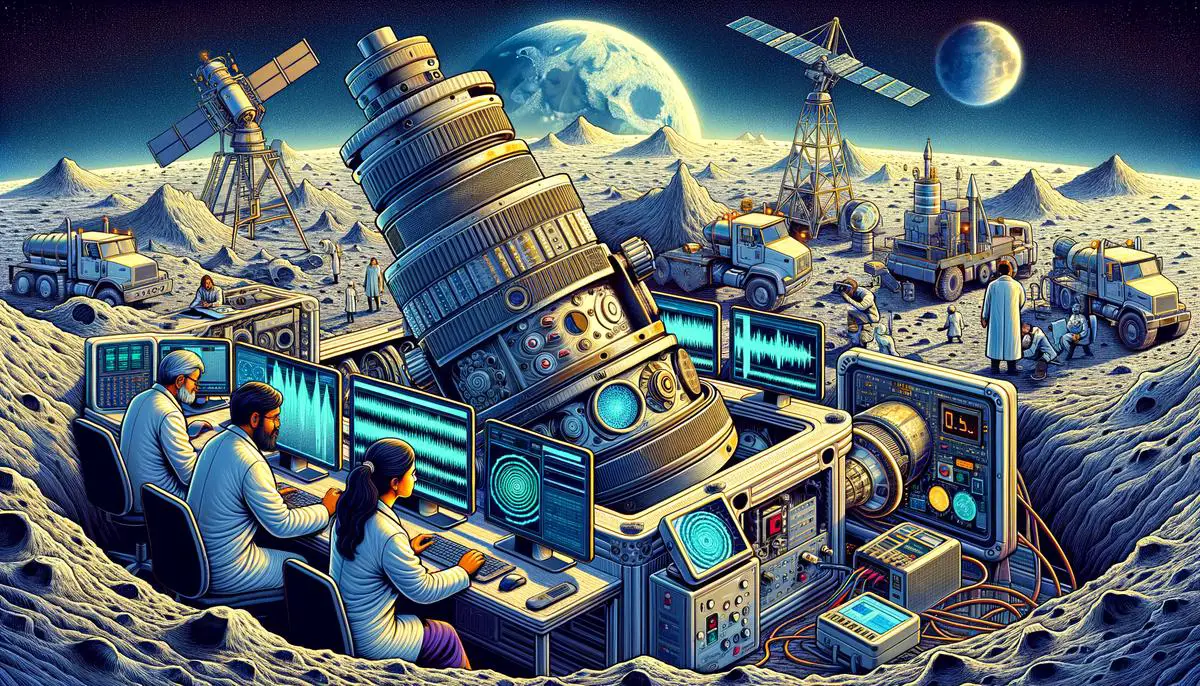The moon, our closest celestial neighbor, has fascinated humans for millennia. Yet, it wasn’t until the era of the Apollo missions that we began to unravel its seismic secrets. These early explorations equipped with the Apollo Lunar Surface Experiment Package (ALSEP), including seismometers, marked humanity’s initial steps towards understanding moonquakes. This exploration wasn’t just about planting flags or collecting rocks; it represented our first foray into decoding the moon’s internal whispers. Through the trials and achievements of these pioneering missions, we laid the foundation for a deeper comprehension of lunar seismic activities, challenging our previous perceptions and setting the stage for future explorations.
Contents
Historical Context of Seismic Studies on the Moon
In the grand venture of exploring our moon, the Apollo missions were not just about landing astronauts and planting flags. These missions brought forth a revolution in understanding the moon’s interior through pioneering lunar seismic studies. It’s a journey of innovation, curiosity, and exploration, marking a leap not only for mankind but for the science of seismology itself.
The Apollo missions, specifically Apollo 11, 12, 14, 15, and 16, carried with them the goal to deploy an array of sophisticated instruments. Among these instruments were seismometers, devices capable of detecting and measuring the moon’s geological activities – its ‘quakes,’ if you will. The motivation? To unravel the moon’s secrets beneath its surface, to understand its composition, and to glean insights into its formation.
Upon their arrivals, starting with Apollo 11, the astronauts skillfully placed the seismometers on the lunar surface. This act alone was a feat of extraordinary importance. For the first time in human history, we were set to monitor another celestial body’s seismic activities in real-time. It was akin to listening to the moon’s heartbeat, an endeavor that promised to expand our knowledge of not just the moon, but planetary formation as a whole.
The data they collected was revelatory. The seismometers detected thousands of moonquakes and provided critical information on the moon’s internal structure. These ranged from deep moonquakes occurring about 700 kilometers below the surface to shallow quakes within the upper 20 to 30 kilometers. Additionally, the instruments captured the seismic impacts of meteorites and the tidal forces exerted by Earth’s gravitational pull on the moon.
One of the most significant outcomes of these seismic studies was the understanding that the moon possesses a thinner, broken crust compared to Earth, revealing the scars of its ancient and tumultuous history. It became clear that the moon’s seismic activity, while less frequent than Earth’s, was a key to unlocking its past. The Apollo seismic experiments also indicated the possibility of a partially molten layer at some depth, hinting at a more complex lunar interior than previously assumed.
This pioneering seismic work didn’t just sit idle. It laid the foundation for future lunar exploration and even influenced how we now investigate other planets and moons. The Apollo seismic experiments are a testament to human curiosity and our profound drive to explore and understand the universe.
Through ingenuity and determination, the Apollo missions gave us the first direct glimpse beneath the moon’s surface, charting a course for the future of planetary seismology. It’s a narrative of human achievement, revealing not just the moon’s secrets, but reminding us of the endless possibilities that await when we reach for the stars.

Analysis of Seismic Data from Apollo Missions
Building on the foundational knowledge gathered from Apollo’s seismic data, scientists and researchers delved deeper into the intricacies of lunar geology, uncovering insights that not only expanded our understanding of the Moon but also offered parallels to Earth’s geological processes. Among these findings, the thermal characteristics of the Moon stood out, revealing a celestial body that, despite its barren exterior, harbors a complex thermal history beneath its surface.
The analysis of the Moon’s thermal state provided clues about its volcanic activity, or lack thereof, in recent geological times. The seismic data indicated that the Moon, though once volcanically active, has largely cooled, with minimal activity in the past billion years. This cooling trend has significant implications for the Moon’s geological evolution and offers a stark contrast to Earth’s continuous tectonic and volcanic dynamism.
Furthermore, the Apollo seismic experiments allowed scientists to compare the Moon’s seismology with that of Earth, highlighting the differences in seismic wave speed and propagation. On Earth, the presence of liquid water and a molten outer core facilitates the transmission of certain types of seismic waves, whereas the Moon’s solid inner structure influences the way seismic waves travel through it. Such comparisons have been instrumental in understanding not just the Moon’s composition but also Earth’s inner workings.
In addition to expanding our knowledge of lunar geology, Apollo’s seismic data have also had a profound impact on the field of planetary science. The methodologies and technologies developed for lunar seismology have been adapted and applied to other celestial bodies, enhancing our capability to study planets and moons beyond our own. For instance, insights gained from the Moon have informed missions to Mars, such as NASA’s InSight lander, which is equipped with seismometers to probe the Red Planet’s internal structure.
This wealth of information derived from Apollo’s seismic experiments underscores the interconnectedness of our solar system’s bodies. By studying the seismic activity of the Moon, scientists have not only unraveled the mysteries of our closest celestial neighbor but also gained valuable perspectives on the broader mechanisms of planetary formation and evolution. The Moon’s seismic story, pieced together from Apollo’s data, serves as a testament to human curiosity and our relentless pursuit of knowledge that transcends our home planet, prompting ongoing exploration and discovery in the vast expanse of space.

Impact of Lunar Seismic Activity on Future Missions
Understanding lunar seismic activity is not just about looking back at the moonquakes of the past; it’s about paving the way for the footsteps of future explorers. As we dive deeper into the tremors of the Moon, we’re unlocking secrets that echo through the vastness of space, shaping our approach to exploring not just our closest celestial neighbor, but also the far reaches of our solar system.
The landscape of lunar exploration was forever altered by the Apollo missions, which laid the groundwork for a nuanced understanding of the Moon’s geology. This understanding reveals stark differences between the Moon and Earth. While Earth’s geology is driven by plate tectonics and a dynamic interior, the Moon’s seismic activity paints a picture of a quieter world, where activity stems from a different playbook. Yet, this doesn’t make the Moon any less intriguing. Its thermal history, for instance, has offered scientists clues about its cooling process over billions of years. Unlike Earth, with its ongoing volcanic eruptions showcasing its fiery belly, the Moon’s volcanic activity has dwindled, suggesting a quieting of its internal dynamics.
But how does this deep dive into lunar geology impact future exploration? Firstly, by understanding the seismic behavior of the Moon, scientists and engineers can design more resilient habitats and equipment. Lunar bases, for the adventurers of tomorrow, will need to withstand the occasional tremors that ripple through the Moon’s surface. Just as architects on Earth design buildings to endure earthquakes, lunar architects will draw on seismic data to safeguard humanity’s future outposts in space.
The Apollo seismic experiments also serve as a beacon for interplanetary exploration. The technologies developed and lessons learned are not confined to the Moon; they’re being adapted for missions to Mars and beyond. The red planet, with its own tales of seismic activity, beckons as the next frontier. Understanding the Moon’s seismic landscape has provided valuable insights into how seismic experiments could be conducted on Mars, offering glimpses into the Martian interior. This interconnectedness of celestial bodies, revealed through seismic studies, underscores the universal principles governing planetary bodies in our solar system.
Moreover, these lunar explorations offer profound insights into the formation and evolution of planetary bodies. The seismic whispers of the Moon tell a story of its birth, its evolution from a molten orb to the serene sphere we gaze upon today. These insights not only quench our thirst for knowledge but also fuel further exploration and discovery. The significance of the Apollo seismic experiments cannot be overstated. They represent a crucial leap in our understanding, not just of the Moon, but of planetary science as a whole.
In wrapping up our journey through the tremors of the Moon, it’s clear that the ripples of lunar seismic activity extend far beyond mere academic curiosity. They influence the very fabric of future exploration, guiding our steps on the Moon, Mars, and beyond. As we stand on the shoulders of the Apollo missions, we peer into the future, a future where the discoveries on the Moon light the way for adventurers venturing into the cosmos. The legacy of Apollo’s seismic experiments is a testament to human ingenuity, a beacon that illuminates the path of ongoing exploration and discovery in the boundless expanse of space.

Technological Advancements in Seismic Monitoring on the Moon
As we venture further into space exploration, a key focus has been to comprehend and monitor the Moon’s seismic activity. This endeavor not only aids in understanding the Moon’s past but also lays a vital groundwork for future lunar bases and further space exploration. The latest advancements in lunar seismic monitoring are reshaping our approach to unraveling the mysteries of the Moon and beyond.
One of the notable advancements in this arena is the development of more sophisticated, durable seismometers designed to withstand the Moon’s harsh conditions. Unlike the ones used during the Apollo missions, these next-generation instruments can capture a broader range of seismic waves with greater sensitivity, providing a clearer picture of the Moon’s seismic activity. This enhancement is crucial for identifying safe zones for future moon bases by detecting areas less prone to moonquakes.
Moreover, advancements in data analysis techniques have revolutionized how we interpret seismic data. Artificial intelligence and machine learning algorithms can sift through vast amounts of data more efficiently than ever before, uncovering patterns and insights that were previously elusive. This capability allows scientists to draw more accurate conclusions about the Moon’s geological processes, volcanic activity, and thermal characteristics.
Additionally, international collaboration has led to the proposal of deploying a network of seismic monitoring stations across the Moon’s surface. This global network would enable scientists to triangulate the source of seismic activity with unprecedented precision, providing a multi-dimensional view of the Moon’s internal structure. It marks a significant leap from the isolated stations of the past, paving the way for a comprehensive understanding of lunar geology.
Furthermore, the integration of seismic monitoring technologies with other scientific instruments on lunar missions offers a holistic view of the Moon’s environment. By correlating seismic data with measurements from other sensors, such as those analyzing the lunar atmosphere and electromagnetic field, scientists can gain insights into the interconnected processes shaping the Moon.
The advancements in lunar seismic monitoring are not just about studying the Moon; they also hold implications for Mars and other celestial bodies. The technologies and methodologies developed for the Moon are being adapted for missions to Mars, providing a blueprint for understanding seismic activity on other planets. This cross-planetary approach enriches our knowledge of the solar system’s dynamics and the formation of planetary bodies.
The legacy of the Apollo seismic experiments continues to influence today’s lunar exploration efforts. The advancements in seismic monitoring are a testament to human ingenuity and our relentless pursuit of knowledge. As we stand on the brink of establishing a permanent human presence on the Moon, these developments ensure that we are well-equipped to build on the foundations laid by the pioneers of space exploration, driving forward into a future where the secrets of the Moon and beyond are within our grasp.

Through the lens of history and the power of technology, our journey to comprehend the moon’s seismic nature continues to evolve. The Apollo missions handed us the first pieces of this complex puzzle, revealing a moon alive with quakes and stirring with geological processes. As we stand on the precipice of new lunar explorations, armed with advanced seismic monitoring technologies and a collective spirit of discovery, we are not just seeking answers to scientific questions. We are reaching for a deeper connection with our universe, one moonquake at a time, peeling back layers to uncover secrets held tight for billions of years. What was once a distant orb in our night sky has become a beacon of exploration, challenging us to think bigger and dig deeper into the cosmic garden’s mysteries.
